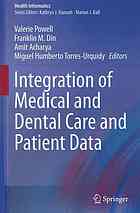

Most ebook files are in PDF format, so you can easily read them using various software such as Foxit Reader or directly on the Google Chrome browser.
Some ebook files are released by publishers in other formats such as .awz, .mobi, .epub, .fb2, etc. You may need to install specific software to read these formats on mobile/PC, such as Calibre.
Please read the tutorial at this link: https://ebookbell.com/faq
We offer FREE conversion to the popular formats you request; however, this may take some time. Therefore, right after payment, please email us, and we will try to provide the service as quickly as possible.
For some exceptional file formats or broken links (if any), please refrain from opening any disputes. Instead, email us first, and we will try to assist within a maximum of 6 hours.
EbookBell Team

0.0
0 reviewsThis book informs readers of the needs and rationale for the integration of medical and dental care and information with an international perspective as to how and where medical and dental care separated into specific domains. It provide high level guidance on issues involved with care and data integration and how to achieve an integrated model of health care supported by integrated HIT. A patient typically expects that a visit to a dentist can usually be resolved immediately. This expectation places a premium on instant, accurate, thorough, and current information. The state-of-the-art of fully integrated (dental-medical) electronic health record (EHR) is covered and this is contrasted with the current state of dental-medical software. While dentists in the US Veterans Health Administration (VHA), the US Indian Health Service (IHS), or the US military, for example, have access to fully integrated health records, most US clinicians still gather information from separate sources via fax or phone calls. The authors provide an in-depth discussion of the role of informatics and information science in the articulation of medical and dental practices and clinical data with the focus on applied clinical informatics to improve quality of care, practice efficiency, coordination and continuity of care, communication between physicians and dentists and to provide a more comprehensive care for the patients. Lastly, the book examines advances in medical and dental research and how these may affect dentistry in the future. Most new advances in healthcare research are information-intensive.